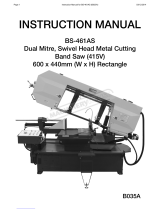
8 DO NOT wear loose or ill-fitting clothing. Remove ties, watches, rings and other jewellery. Tie up, or adequately cover, long hair.
8 DO NOT start the bandsaw until the workpiece is secure and the blade has been lowered to just above the workpiece.
8 DO NOT run the bandsaw with the blade in the raised position.
8 DO NOT use the bandsaw in areas where fumes from paint, solvents, or flammable liquids pose a potential hazard. Keep all flammable
materials (including wipes or cleaning rags) away from the saw, and dispose of according to local regulations.
8 DO NOT leave the bandsaw running unattended. Turn power switch ‘Off’ and DO NOT leave area until the blade has come to a complete
stop.
8 DO NOT use whilst under the influence of drugs, alcohol or other intoxicating medication.
8 DO NOT use the bandsaw with the blade guards or bow rear cover removed.
8 DO NOT stand on the bandsaw.
8 DO NOT use damaged or deformed bandsaw blades.
8 DO NOT use the bandsaw in wet or damp locations.
8 DO NOT use the bandsaw if you are fatigued.
9 Turn the bandsaw OFF before raising the blade.
9 Wear protective gloves when handling workpiece and saw blades.
9 Always secure the workpiece in the vice.
9 Keep correct footing and balance at all times and wear non-slip shoes with steel toe caps.
2. i INTRODUCTION
Manufactured to comply with Safety of Machinery (Safety) Directives 1992 (and amendments) and fully CE approved. Saw arms are
fitted with hydraulic damping to prevent the arm being dropped onto the workpiece and to ensure smooth cutting performance. Bow
rotates up to 60° angle allowing workpiece to always sit in a central position. Coolant fluid system and main power controls are
switched on individual 24V/230V circuits for extra safety. Features auto and manual shut-off switches giving the user options of control
when in use. Heavy-duty single phase electric motor.
3. i SPECIFICATION
Model No: ..............................................................SM355CE
Capacity 60° - Round: ............................................ Dia 90mm
Capacity 60° - Square: ................................................. 85mm
Capacity 45° - Round: .......................................... Dia 150mm
Capacity 45° - Square: ............................................... 145mm
Capacity 0° - Square: ................................................. 220mm
Capacity 0° - Round: ............................................Dia 220mm
Capacity 0° - Rectangle (H x W): ......................255 x 150mm
Blade Size: ...............................................2450 x 25 x 0.9mm
Blade Speed: ........................................................... 72m/min
Coolant Pump Power: .....................................................25W
Motor Power:............................................................... 1100W
Supply: ...........................................................................230V
Overall Size (W x D x H): ....................1720 x 800 x 1810mm
4. HANDLING AND INSTALLATION
4.1. TRANSIT AND LIFTING
4.1.1. A fork lift truck will be required to unload the palletised
bandsaw and transport it to the installation area.
4.1.2. A suitably rated crane used together with chains and shackles
should be used to lift the machine onto the sheet metal stand
and also to lift the whole assembly into its intended position.
See lifting points B & C in Fig.2 above. Alternatively, slings can
be used under the vice either side of the central pivot. Great
care should be taken to keep the load level and to ensure that
the slings DO NOT apply pressure to components that should
not be heavily stressed.
4.2. INSTALLATION AREA
4.2.1. Ensure that there is adequate free space around the machine
bearing in mind that it may be necessary to cut from long
lengths of steel stock that need to be fed over the roller
attached to the back of the machine and that the stock will
need to be supported along its length beyond the machine.
4.2.2. The surface on which the machine is to be mounted should
be at and level and capable of supporting the weight of the
machine and the workpieces.
4.2.3. Ensure that the work area is adequately illuminated.
4.2.4. The machine should be located near a power supply point that is equipped with an overload cut out and suitable earthing.
4.2.5. The installation area should be free from excessive humidity and atmospheric agents that could ignite.
4.3. ASSEMBLY
4.3.1. Remove the outer packaging and dispose of it responsibly in accordance with local authority regulations.
4.3.2. SHEETMETAL BASE
4.3.2.1. Identify the front panel which has a small access plate bolted to it near the top edge. This front panel has a returned ange
along either vertical edge. Bolt an end panel to each vertical ange using the Ø8mm bolts, nuts and washers supplied as shown below.
Complete the structure by bolting the back panel into place as shown below in Fig.3.
4.3.2.2. Using a suitable crane, lower the machine bed onto the top of the assembled stand. The stand assembly has two large threaded
inserts on either side ( see Fig.3 ) and these should be aligned
fig.1
fig.2
Original Language Version
© Jack Sealey Limited SM355CE Issue 5 (5) 28/05/21









